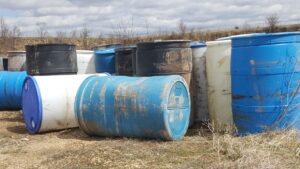eMail of May 13, 2020:
As discussed on the phone this afternoon, <<Company>> is a specialty chemical company supplying a wide range of Industrial Chemicals, some of which are considered hazardous (most because they contain either caustic or acidic components for cleaning or pretreatment). We have a customer that wants to return the empty drums so we can refill them with the same product as a cost savings for both our customer and us. My question is what does the customer need to do prior to shipping them back to us via common carrier. In our phone conversation you mentioned that the drums needed to be “RICRA Empty” less than an inch remaining in the drum and they did not need to be triple rinsed and they could leave the original labels on the drum. Let me know what else needs to be done in order for the customer to return these drums and what paper work is needed in order to return the drums.
Daniels Training Services, Inc. 815.821.1550 |
My reply May 14, 2020:
Thank you for contacting me. I apologize for not getting this to you last night. Please see below for answers to your questions.
- The first responsibility of your customer(s) is to ensure the drums are RCRA Empty as that term is regulated by USEPA. This ensures the drums and any remaining residue are not subject to USEPA regulations (and most states) as a hazardous waste. In brief, RCRA Empty requires both of the following:
- Get all HazMat out that can be gotten out using common practices (e.g., gravity flow when tipped, pump, etc.).
- No more than 2.5 cm (1″) of residue remains on the bottom of the packaging. (Customer should get more out if they can).
- This is important to you. If you receive and process drums that are not RCRA Empty you could be fined for unpermitted processing of a hazardous waste.
- Triple rinse is not required to get a drum RCRA empty.

- Some states (California) have a more strict requirement for a drum to be considered empty.
- Once RCRA Empty the drums should be closed tightly and stored in an area where they will not contribute to storm water pollution. (Try to keep them indoors if possible, no residue on outside).
Contact me with any questions you may have about the generation, identification, management, and disposal of hazardous waste Daniels Training Services, Inc. 815.821.1550 |
USDOT/PHMSA Regulations:
- When offered for transportation, your customer will be subject to USDOT/PHMSA regulation as a shipper of a hazardous material. You will be subject to regulation as the carrier.
- If customer is able to remove all hazards (triple rinsing is not specified, a single rinse may suffice), then drum is not subject to USDOT/PHMSA Hazardous Materials Regulations (HMR). It is up to the shipper of the HazMat to determine if all hazards have been removed. The carrier should confirm this before accepting the consignment.
- If any residue of the HazMat remains, customer must comply with USDOT regulations of 49 CFR 173.29. This is summarized below:
- All USDOT labels and marks must remain on drums. Customer may need to replace missing or damaged USDOT labels/marks.
- Labels and marks not required by USDOT regulations (e.g., OSHA pictograms, product name) may be removed or may remain.
- If all of the following are true, consignment of RCRA Empty drums does not require placards to be displayed on the truck (however, all other requirements of the HMR remain):
- Non-bulk packaging (e.g., a drum).
- A HazMat found in Table 2 at 49 CFR 172.504 (e.g., Class 8 Corrosive).
- If the consignment is also transported by a contract or private carrier, then a shipping paper is not required either.
- Contract carrier performs transport under terms of contract.
- Private carrier is owner of HazMat in transportation, is not a third person transporter, and does not transport for hire.
- If consignment is transported by common carrier, then shipping paper is required. (In your phone call you mentioned a common carrier).
- Common carrier is JB Hunt, Schneider, Conway, &etc.
- Shipping paper may include: “Residue last contained…” with proper shipping name.
- Regardless of above, all other requirements of USDOT/PHMSA Hazardous Materials Regulations remain including HazMat Employee training for all involved in transport.
- Once you receive the drums you may prepare them for reuse according to the HMR of USDOT/PHMSA.
In sum: if your customer can get the drums RCRA Empty, the drums can be transported back to you (USDOT regulations vary) for reuse and return to customer.
Contact me with any questions you may have about the transportation of hazardous materials by air, highway, vessel, or rail International and Domestic Daniels Training Services, Inc. 815.821.1550 |

